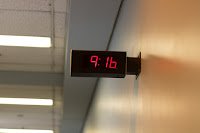AWB
Tungsten Light WB
Custom WB
In this case, the AWB gives a warmer colour cast (bit of orange), the Tungsten Light WB a little bit of blue in the picture and the Custom WB gives a cooler cast (greenish cast). Maybe it was the lighting of the library, but maybe how I took my picture of the white paper for the custom WB had affect the result.
2. Shoot in an area where there are two different colours of light
In order, the first picture was taken with the AWB, the second with Shade WB and the third with White Fluorescent Light WB.
In the first picture, the AWB gives a grey hue. It was cloudy and snowy.
 In the second picture, the Shade WB gives a warmer cast and in the last picture, due to the Florescent WB, there is a cooler cast (very blue cast). The blue cast is given by the Fluorescent preset that is normally use for indoor pictures (like in a room, hallway) but in that case it was near a window so there was shade light and fluorescent light.
In the second picture, the Shade WB gives a warmer cast and in the last picture, due to the Florescent WB, there is a cooler cast (very blue cast). The blue cast is given by the Fluorescent preset that is normally use for indoor pictures (like in a room, hallway) but in that case it was near a window so there was shade light and fluorescent light.3. Purposefully shoot with the wrong WB preset in order to introduce an overall colour cast to your image.
In order, AWB, Daylight, Shade, Cloudy, Tungsten Light, White Fluorescent Light presets.
For the outdoor presets (Daylight, Shade, Cloudy), the colour cast is warmer. For the indoor presets (Tungsten & Fluorescent), the colour cast is a lot cooler.
 In that case, just like the pictures near a window, the clock is also near the window so we have shade light and fluorescent light. I think the AWB was the best for these pictures.
In that case, just like the pictures near a window, the clock is also near the window so we have shade light and fluorescent light. I think the AWB was the best for these pictures.




































